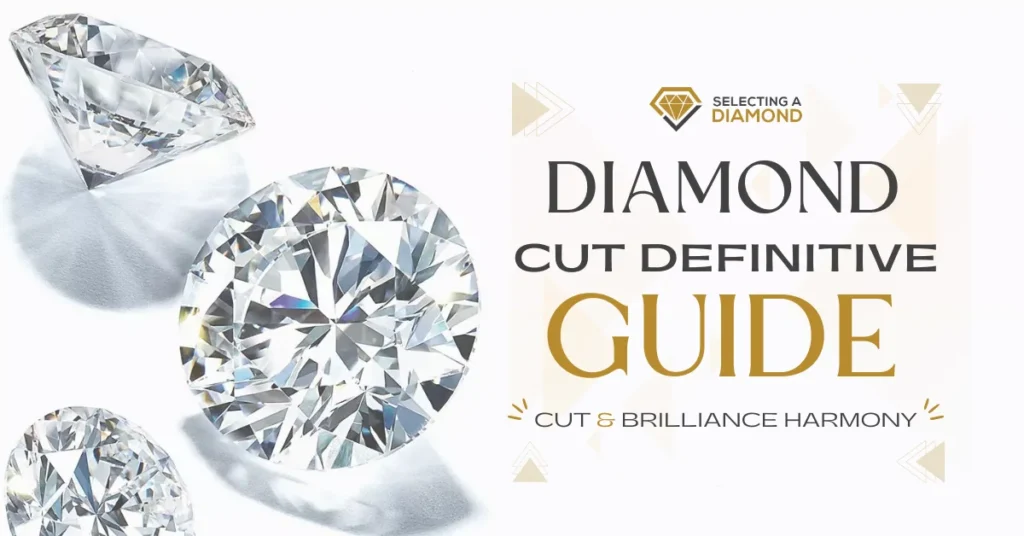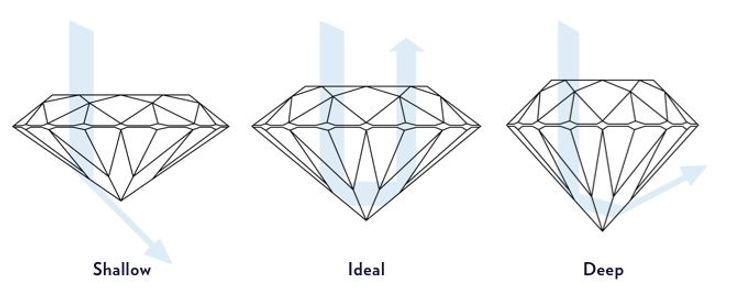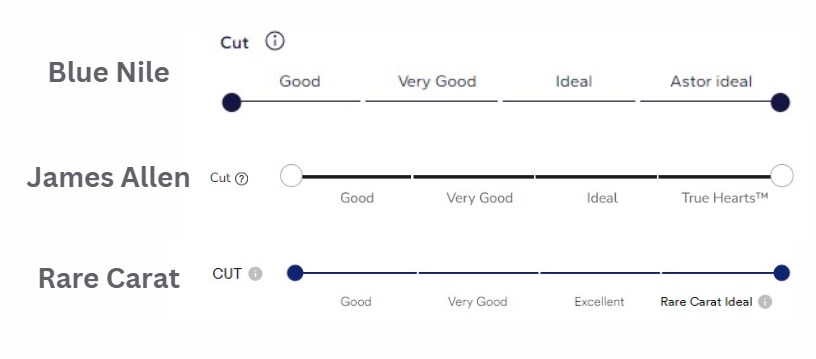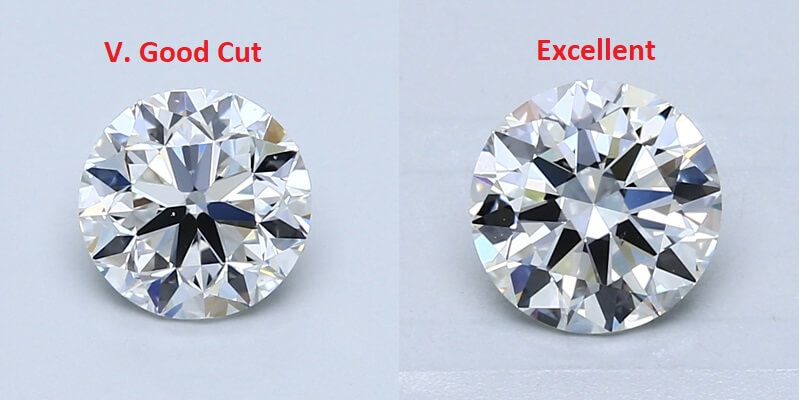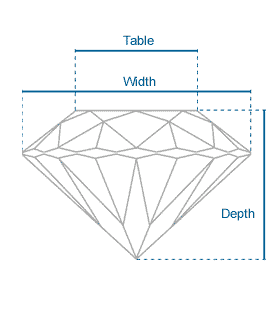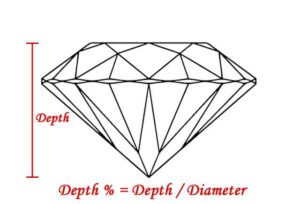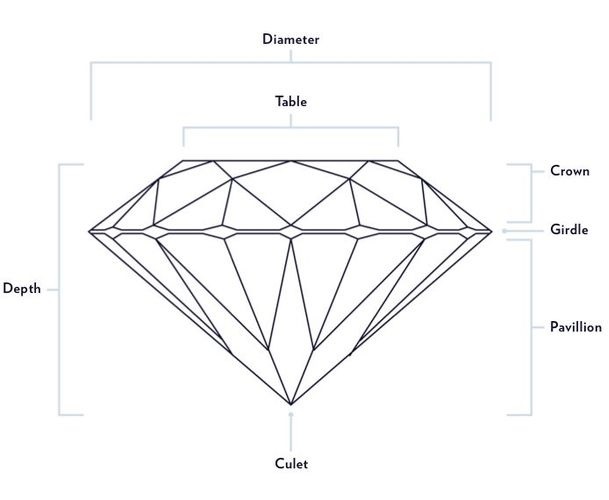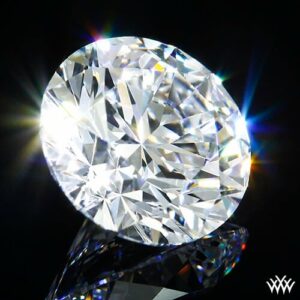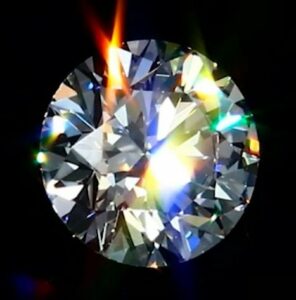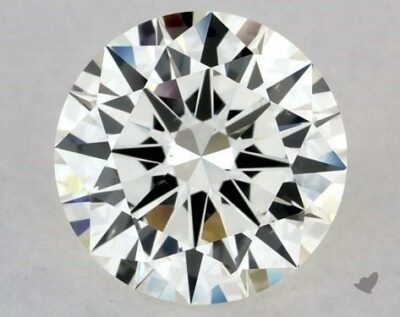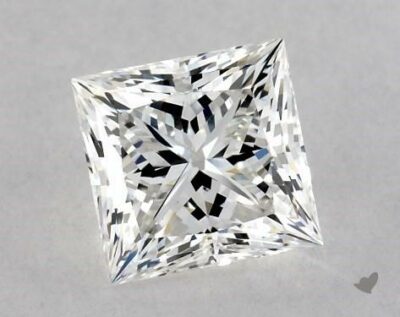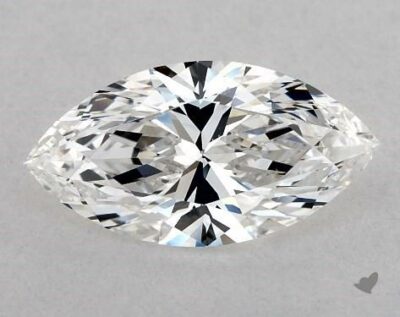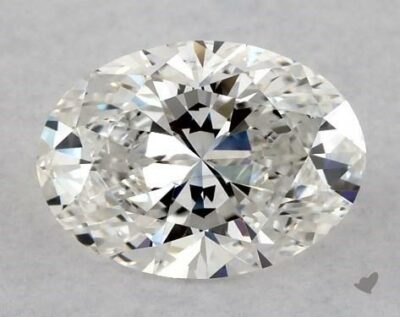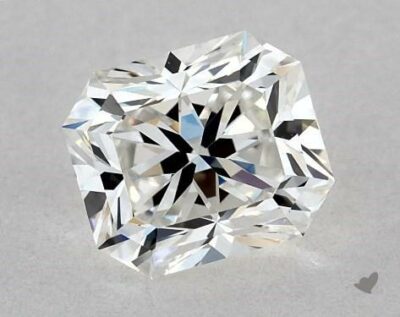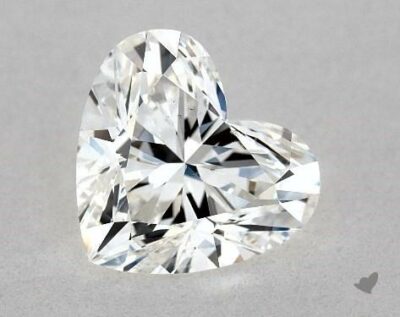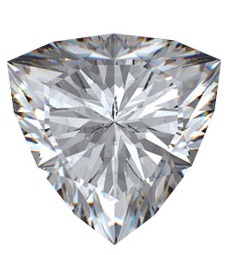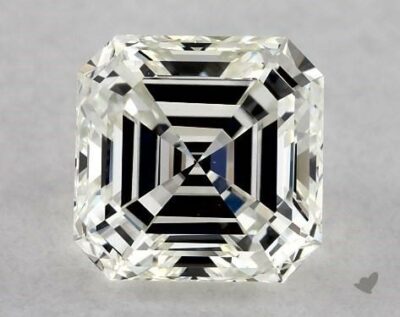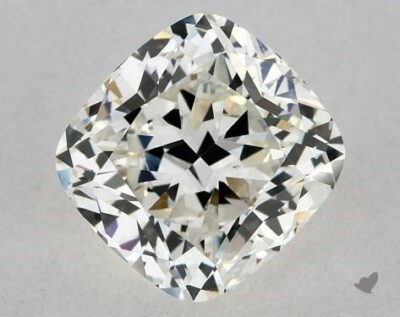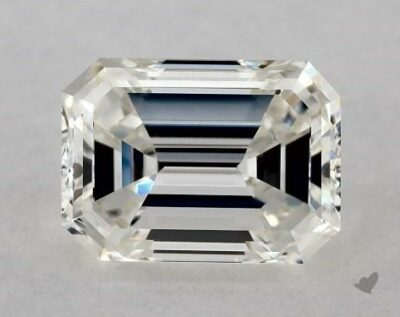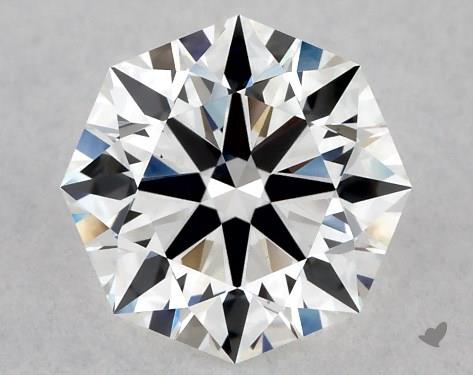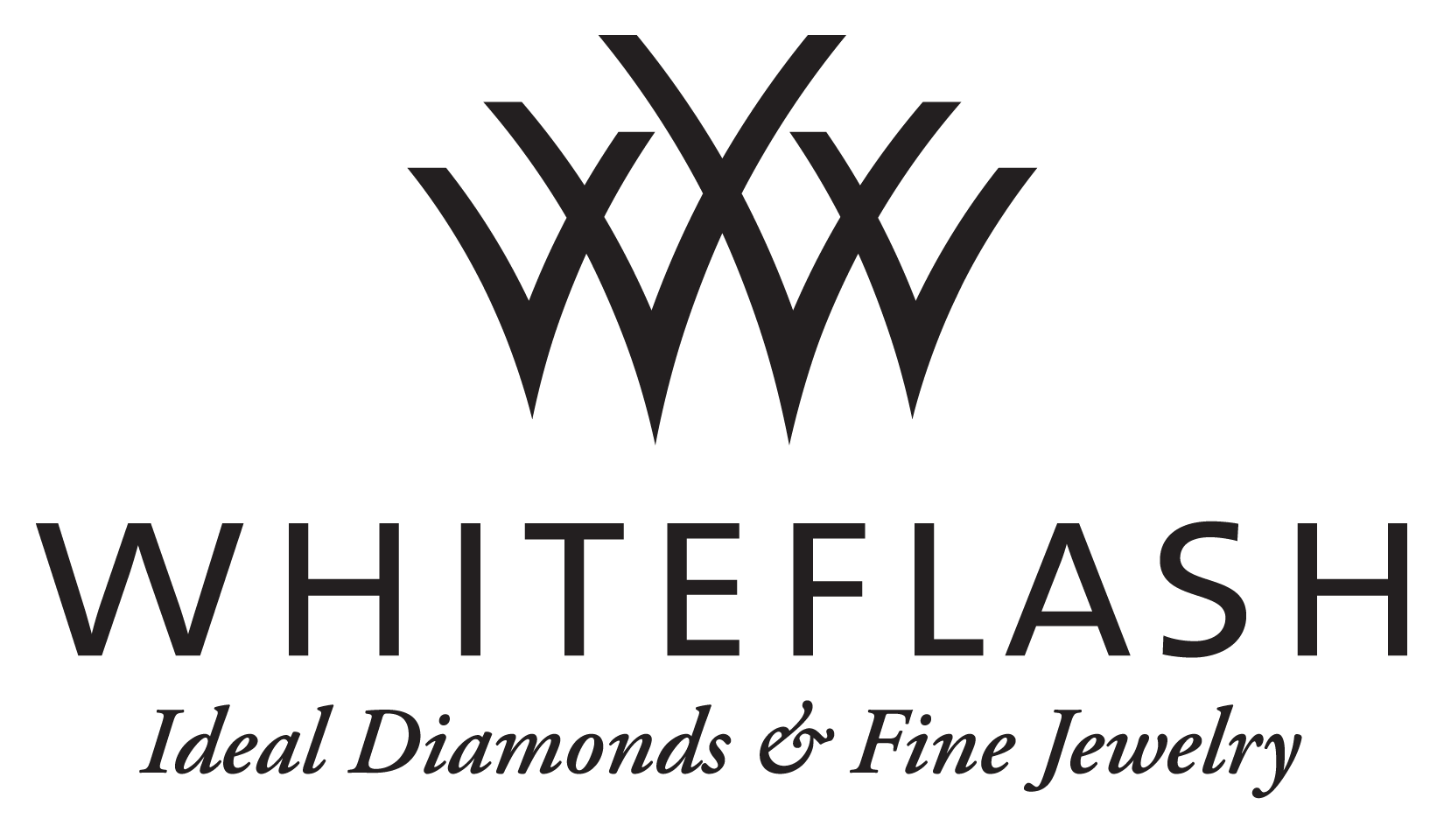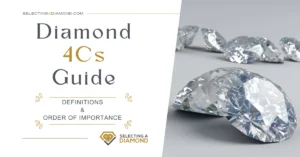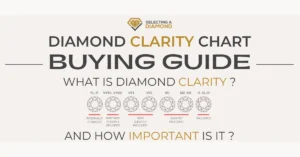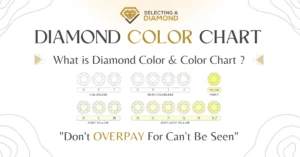We may earn a commission when you purchase through our affiliate links, at no extra cost to you. This helps support our work and allows us to continue providing unbiased, expert diamond advice.
Summary in a few lines:
When selecting a diamond, the cut is crucial, it’s the most important factor of all 4Cs of a diamond.
GIA standardize diamond cut by creating a grading system, grading diamonds from Excellent to Poor.
Always prioritize getting an excellent cut diamond over anything else (carat, color, clarity), as this significantly impacts the gem’s brilliance and overall quality.
Look at these three diamonds, identical in the 3Cs, with the except of cut grade:

You would think good is actually good, but in diamonds, good cut is really bad, even v. good isn’t that good as we you see, that’s why you always have to seek an excellent, and nothing below that.
To inspect the diamonds in greater details and see their table & depth percentages, feel free to browse the not-so-good diamond, then the average one, and there you go the excellent choice.
The guide explores the importance of cut, its controversial nature, grading, and its effect on light reflection in diamonds, and if you’ve mistakenly equated ‘diamond cut’ with ‘shape,’ then feel free to check our guide to the most popular diamond shapes.
What is Diamond Cut?
Diamond cut refers to the proportions of the parts of the diamond, and how well the diamond facets reflects light when exposed to direct light.
Ever noticed how some diamonds dazzle brilliantly while others don’t?
That’s what exactly is the diamond cut.
A diamond cut is not just about its shape but involves the precise proportions and angles of its facets, ensuring maximum light reflection. It’s an art where skilled craftsmen aim for perfect symmetry, proportion, and polish to enhance the diamond’s sparkle.
Take, for example, two diamonds from James Allen, both might seem similar in size, color, and clarity, this one is with a good cut, while the other has very similar characteristics, but with an excellent cut.
Look closer, especially with tools like a 360-degree view or 40x magnification, and you’ll see a stark difference in how they shine.
That difference? It’s all in the cut.
Let’s get a little deeper and explore how a diamond’s cut directly influences its brilliance and why choosing the right cut can make all the difference in your diamond’s allure.
Diamond Cut Effect on Brilliance & Light Reflection
Look at this 3 images (from Blue Nile), you can easily tell why the cut is the most important factor in making the light reflect from the diamond, creating that magical brilliance:
The cut of a diamond is an artful science, determining its brilliance and sparkle. It involves a harmonious balance of the diamond’s proportions, including its dimensions, surface polish, depth, and symmetry.
These elements combined dictate the diamond’s ability to reflect light. The more harmonious these elements, the more stunning the diamond’s reflection and sparkle.
Among the 4Cs of diamond quality, the cut reigns supreme. It significantly affects a diamond’s appearance to the naked eye.
A slight change in clarity or color might go unnoticed, but a drop from an ‘Ideal’ to a ‘Good’ cut grade? That’s something you’ll see right away as it noticeably reduces its sparkle, showcasing the cut’s vital role in enhancing a diamond’s natural beauty.
Remember, each diamond is unique, and its cut plays a pivotal role in showcasing its individuality and brilliance.
Fact: It has been proven by Gem professionals that no two diamond stones are identical! You can never find two stones that have the same characteristics although they might actually look exactly the same under a layman’s vision.
Shallow vs Deep vs Ideal Cut
On the image we saw above, it’s clear that when a diamond is Cut to excellent & v. good proportions, light is refracted from one facet to another, then dispersed through the top of the diamond.
And although the shallow diamond will look bigger (when looking from above), but that’s not what you should be looking for, as this cut (ironically named good) isn’t good at all in reflecting light.
What makes the diamond notable isn’t it size, but how the light “dances” when the hands move, so don’t look for a larger diamond before guaranteeing an excellent cut.
Remember this:
When a diamond is cut too deep, some light escapes through the opposite side of the diamond.
On the other hand, if the diamond’s cut is too shallow, the light will escape through the bottom of the stone before it even has the chance to be reflected.
As you see in this similar illustration:
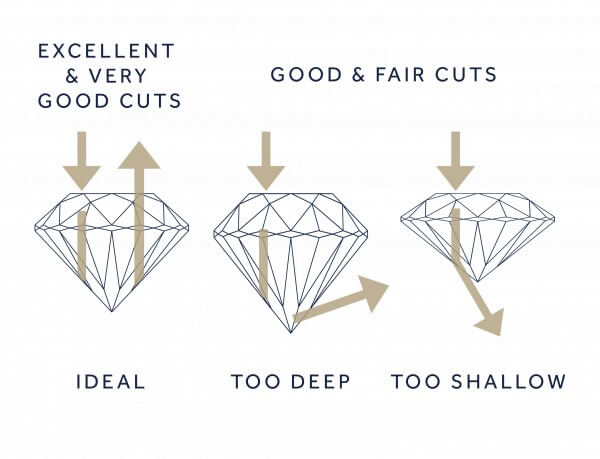
Understanding Diamond Cuts: A Detailed Guide to Grade Scale and Chart
Just as there are charts for clarity and color in diamonds — with the clarity chart indicating the purity of the diamond and the color grades chart revealing how colorless a diamond is — there also exists a grading chart for diamond cuts, with the most widely accepted being the GIA Cut Grading Chart.
This chart breaks down diamond cuts into five primary grades: Poor, Fair, Good, Very Good, and Excellent (also known as Ideal cut).
Tip: Some retailers like James Allen or Blue Nile may offer a ‘Super Ideal’ grade, we will see more about this grade shortly, but it’s worth mentioning that it’s not a grade defined by GIA.
Let’s talk a deeper look on each of these 5 grades:
1) Poor
These diamonds are the lowest in terms of quality, often lacking in brilliance and fire.
Poorly proportioned, they reflect little light, resulting in a dull appearance. Typically, they are either too deep or too shallow, causing light to escape from the sides or bottom.
Despite the fact that the probability of the existence of these types is uncertain, all reputable online diamond stores (like James Allen and Blue Nile) do NOT sell any poor cut diamonds.
2) Fair
Not the worst, but fair-cut diamonds have limited sparkle due to their subpar cut.
Slightly better than poor, fair cut diamonds exhibit some sparkle but still miss out on full light reflection. These diamonds may appear decent but don’t optimize their potential for brilliance and fire.
Similar to poor cut diamonds, it’s very unlikely to find a fair cut diamond in reputable online stores as well, if you found one in a local store, always make sure to see & verify diamond certificates before proceeding with the buying decisions!
Tip: Even if you find yourself on a very low budget and you came across this grade, we would never recommend you get it, and if you were on a very tight budget, think about getting a lab-created diamond instead, just NEVER ever get a fair-cut diamond.
3) Good
These diamonds are partially well-cut (based on the quality of sparkle that they give). They are cut in a way that they don’t lose their beauty or quality. And although they don’t reflect all the light penetrating them, they are still considered not that cheap!
You can find good cut diamonds on almost all online merchants (although very little options), but if you want our professional opinion, we wouldn’t recommend this grade, a good grade is NOT that good when it comes to brilliance.
4) Very Good
These diamonds are cut to produce a lot of sparkle, nearly maximizing the stone’s potential. They reflect nearly all light that enters, striking a balance between quality and cost. Very Good cuts are popular for their good brilliance and fire.
We consider this grade to be, how can we say that, the most budget-friendly one of all! (it’s still expensive though).
While we always recommend trying to get excellent (ideal) even for lower carats, a lot of people go to v. good because it’s cheaper.
5) Excellent | Ideal
If you’re asking: What is the Best Diamond Cut out there?
The Excellent cut, no question!
Always seek an ideal cut even if it means getting a lower carat!
The highest standard, these diamonds are masterfully crafted to achieve maximum brilliance and fire. They reflect virtually all the light that enters, resulting in a superb sparkle. Diamonds with this cut are top-tier, offering the best in terms of beauty and quality
Ideal & Excellent terms are used interchangeably in diamond online stores & merchants, but in terms of diamond certificates, AGS considers Ideal as the grade above excellent (which we will see shortly), GIA however, doesn’t define any grade higher than Excellent.
Symmetry and proportions (even Hearts & Arrows) of this grade are set to the most ideal figures, leaving a very small difference for the next “unofficial” grade when these metrics have reached the maximum.
Here are images for two diamonds we found on Blue Nile, both have almost identical characteristics, except for the cut: the left is very good (link) and the one to the right is excellent (link), you can clearly spot the difference between these two grades:
Fact: Only 3-5% only of global diamonds make it to this grade which makes it pretty understandable why they are this expensive.
5.1 Super Ideal (Hearts & Arrows)
Although not officially recognized as an industry standard and not numbered as the sixth grade, the ‘Super Ideal’ cut deserves special mention.
Characterized by a perfect blend of Scintillation, Fire, and Brilliance, these diamonds represent the pinnacle of cutting craftsmanship, earning their place at the top of the grading system.
Retailers often have unique names for these top-tier diamonds: James Allen labels them True Hearts™, Blue Nile calls them Astor By Blue Nile, and Whiteflash features A CUT ABOVE grade.
Super Ideal diamonds boast exceptional light reflection, yet remember, this grade isn’t acknowledged by GIA. Thus, you won’t find it on GIA certificates. Only A CUT ABOVE has recognition on AGS certificates, not GIA’s.”
What Factors Make a Diamond Cut Grade?
When exploring the beauty and value of a diamond, the cut grade stands out as a main player, it’s actually the most important factor among the 4Cs .
Cut grade isn’t just a measure of a diamond’s shape; it’s a reflection of its overall proportions, symmetry, and ability to interact with light, that’s why we’ll delve into the key components that define a diamond’s cut grade:
Proportions, Symmetrical Facets, Brilliance, Fire, and Scintillation.
Understanding these factors can provide deeper insight into what makes a diamond truly sparkle and stand out, helping you appreciate the fine craftsmanship behind every gleaming facet.
1) Diamond Proportions
The proportions of a diamond, particularly its table, width, and depth, play a critical role in its cut grade.
Ideal proportions ensure that light is captured and reflected effectively, enhancing the diamond’s overall brilliance.
Table Proportions
The table, or the flat top surface of the diamond, plays a key role in light reflection. The proportion of the table size relative to the diameter of the diamond is crucial.
An ideally proportioned table allows for optimal light dispersion, enhancing the diamond’s sparkle.
Depth Proportions
Depth proportion is about the height of the diamond from its table to its culet (bottom point). This aspect is critical for optimal light reflection and refraction within the diamond. Too deep or too shallow a depth can cause light to leak out, diminishing the diamond’s brilliance and fire.
Proper depth proportion ensures that light travels correctly inside the diamond, contributing significantly to its overall sparkle.
Width Proportions
Width proportion in a diamond refers to the balance between the width and the other dimensions of the diamond, particularly its depth.
The width, often correlated with the girdle (the widest part of the diamond), is crucial for the stone’s overall balance and symmetry. An ideal width ensures that the diamond can efficiently capture and reflect light, contributing to its brilliance and fire.
The 60/60 Diamond Cut: Navigating Table and Depth Proportions
By now, we know that the depth percentage is calculated by dividing the stone’s height by its overall width, and the table percentage is the ratio of the table’s width to the diamond’s overall width.
Then you hear a “rule” of 60/60.
This rule suggests choosing diamonds with a table and depth of 60%, is this true?
This can be served as a starting point than a strict rule to follow, you need to delve into the ideal proportions for table and depth and understand what makes a great diamond cut in terms of table & depth.
In terms of certifications for this rule, it’s worth noting that each diamond shape has its ideal proportions, with round diamonds most clearly defined in certifications.
The GIA and AGS consider overall proportions, allowing for some flexibility from the 60/60 rule. These labs now focus more on light return than rigid numerical standards.
Crown
The crown of a diamond is its upper part, stretching from the girdle to the table. This segment plays a crucial role in refracting light into the diamond and contributes significantly to the stone’s overall brilliance and dispersion of light.
For a visual illustration, here is an anatomy of all these proportions of a round diamond (image source: Blue Nile):
2) Symmetrical Diamond Facets
Diamond facets — the mirrors, windows, and steps — are the critical reflective surfaces that encircle the diamond’s table, extending above and below the girdle and culminating in the pavilion at the base.
For example, a typical round brilliant cut diamond boasts 58 such facets. The magic lies in the precise symmetry, size, and strategic placement of these facets.
Imperfectly aligned or unevenly sized facets can significantly detract from a diamond’s ability to refract and reflect light effectively.
The right balance and symmetry of facets are essential for achieving the desired brilliance and ensuring that the diamond sparkles to its full potential.
3) Brilliance
This is actually the most common type among light reflection methods. It’s the white light that we see when we look at a diamond, it’s the light that passes through to the diamond and then reflects back off the surface and into our eyes.
When light enters a diamond and clashes into one of the facets, it keeps bouncing off between mirror-like facets endlessly and this is what really causes a great sparkle.
Brilliance refers to the intensity of the white light reflected from a diamond. A well-cut diamond will exhibit high brilliance, making it appear luminous and radiant.
Some very good/ideal Cut diamonds reflect all the light as white color, the lights get into the diamond white and leave white.
On the other hand, due to a less professional diamond cut, the light enters as white and reflects as rainbow, this image shows both cases (image taken from Whiteflash, house of A CUT ABOVE diamonds):
4) Fire
This is a myriad of colors that reflects when light penetrates the crown of the diamond. The light internally bounces back and forth in the diamond and flashes the eyes in a myriad of colors.
Do you see the rainbow that reflects back from a diamond? This is what Dispersion or Fire represents! It’s the rainbow of colors that reflects back to your eye when you look at a diamond.
The Light; similar to the first left diamond in the last image, enters through the top and breaks down into a rainbow of spectral colors, then reflects in the interior of the gem by bouncing off the mirror-like facets.
Therefore, when it leaves the diamond (through the crown), it doesn’t get mixed with the entering light, rather, it appears as an independent beam until it reaches the eye in flashes of colors.
5) Scintillation
Do you notice when you look at a moving diamond how light reflects through that? This is exactly what is described as scintillation, it’s basically the light symphony playing in front of you when you move the diamond in different angles under the light and it’s demonstrated by the sparkles on the diamond’s surface.
You can see it in the same image we used to demonstrate brilliance, the only difference with scintillation is that scintillation appears when you move the diamond.
As you see in this image, when such a diamond is moved around the light, you can see different angles of reflecting color, a very good diamond cut will retain a good reflecting light when this happens.
1 Carat Round Diamond Prices By Cut Grade
Diamond pricing is influenced by several key factors, including the four Cs: Cut, Color, Clarity, and Carat, and before all that, the shape (the physical shape, not the actual cut grade).
To provide a clearer understanding of how these elements affect cost, we will focus on diamonds with specific characteristics:
Color Grade: H
Clarity Grade: VS2
Carat weight: 1
Shape: Round
We will get our prices from James Allen & Blue Nile, as they offer best diamond prices online.
Good Cut Grade Price Range
For diamonds with a Good cut grade, the price range typically falls between $3000 and $3700. This reflects the cut’s impact on the diamond’s overall appearance and luminosity.
Very Good Cut Grade Price Range
Moving up to the Very Good cut grade, the price range increases to between $3500 and $4700. This increment reflects the enhanced quality and brilliance that comes with a finer cut.
Excellent Cut Grade Price Range
The Excellent cut grade represents the pinnacle of craftsmanship, offering the highest level of sparkle and beauty. Accordingly, diamonds in this category are priced between $4200 and $5500 , marking them as premium choices for those seeking exceptional quality.
These price ranges demonstrate how the cut grade, along with color, clarity, and carat size, can significantly influence the overall cost of a diamond.
Mastering Diamond Selection: The Art of Choosing the Right Cut
While we often recommend going with the lowest eye-clean diamond Clarity like an SI1, and on Color, we don’t recommend exceeding H or G grades in all cases, in cut, we’re changing direction here on the Cut!
When it comes to cut we urge you to spend more for higher quality and go for the highest cut grade you can possibly afford.
Selecting the perfect diamond is an art, with the cut being a central aspect of its beauty. Here’s how to make an informed choice focusing on the diamond’s cut:
- Understand Cut Grades: Start by learning about the different cut grades – Poor, Fair, Good, Very Good, and Excellent. Each grade reflects the diamond’s ability to reflect light and sparkle.
- Prioritize Brilliance and Fire: Choose diamonds with exceptional brilliance and fire, as these qualities are indicative of a superior cut.
- Assess Proportions and Symmetry: Examine the diamond’s proportions and symmetry. These factors are crucial for optimal light reflection and overall aesthetics.
- Review Certifications: Look for diamonds certified by reputable institutions like the GIA or AGS, which provide detailed cut quality information.
- Visual Inspection: If possible, visually inspect the diamond. High-quality imaging tools can also be useful in assessing its sparkle and overall appeal.
- Consult Experts: Don’t hesitate to seek advice from experienced jewelers or gemologists who can guide you based on your preferences and budget.
Remember, the cut of a diamond is pivotal in determining its overall allure, making it a key factor in your selection process.
Diamond Cuts vs. Shapes: What’s the Difference?
Ever wondered what’s the difference between diamond shapes & diamond cuts?
You’re not alone.
A common misconception about diamond cut would be that most people refer to diamond shapes as cuts where they’re not, diamond cut is more about the symmetry, proportioning, and polish of a diamond.
Where diamond shape is as it implies, the shape (that you can tell when you look at the diamond) of a diamond, whether it’s a Round, Princess, or other shapes as we will see now.
Here, we take a quick overview of the most common diamond shapes, however, if you want the full exclusive review, feel free to read Diamond Cut vs. Diamond Shape & The Most Popular Shapes.
Popular Diamond Shapes
In the 1400s, diamonds gained popularity being used as jewelry ornaments. During that time various diamond cuts and diamond shapes were developed.
In 1919, Marcel Tolkowsky invented the Ideal Cut diamond, which quickly became recognized as the standard in round diamonds and the basic shape to be used in diamond engagement rings!
Below is a quick brief review of the most popular diamond shapes used today:
1) Round Shape Diamonds
Round diamonds are by far the most popular diamond shapes. They’re considered the norm in the classic engagement ring: a round, solitaire diamond set either in yellow gold or platinum.
Almost all the shapes other than the round shape are called fancy shapes. The most popular round cut is the Ideal cut diamond which has 58 facets.
Shop for Round Shape Diamonds on James Allen
2) Princess Shape Diamonds
To get into the fancy diamonds topic, we would definitely start with Princess-cut diamonds.
These are considered the most popular of all fancy-shaped diamonds. Princess-cut diamonds are relatively new with an oblong shape; usually a square or almost square but with a modified brilliant cut arrangement of facets instead of a step cut.
Most square or rectangular cuts however don’t live up to the level of the sparkle of the round brilliant, the princess cut diamonds though, are designed to obtain the maximum brilliance from a square cut.
Princess shape (along with round and cushion) can be cut to a perfect proportion that’s even more than excellent, which is called “Heart & Arrows” or Super Ideal.
Some vendors (as we saw above) have a separate premium collection for those, we came across some like True Hearts™ by JamesAllen, and A CUT ABOVE® by Whiteflash.
Shop for Princess Shape A CUT ABOVE® Diamonds on Whiteflash
3) Pear Shape Diamonds
Pear-shaped diamonds are deemed a hybrid cut; combining the best of the oval and the marquise and as the name insinuates, they’re shaped like a teardrop.
Pear-shaped diamonds also complement a hand with small or average-length fingers. It works exceptionally well in pendants or earrings.
Shop for Pear Shape Diamonds on Blue Nile
4) Marquise Shape Diamonds
Marquise diamonds have an elongated shape with pointed ends supposedly inspired by the smile of the Marquise de Pompadour and commissioned by the Sun King, France’s Louis XIV. It is often used as a solitaire or enhanced by smaller diamonds.
Shop for Marquise Shape Diamonds on James Allen
5) Oval Shape Diamonds
Oval diamonds give an even, perfectly symmetrical design and it’s very popular among women with small hands or short fingers. Oval diamonds also have an elongated shape; making a woman’s finger appear longer.
Shop for Oval Shape Diamonds on James Allen
6) Radiant Shape Diamonds
Radiant cut diamonds have a square or a rectangular cut combining both the elegance of the emerald cut diamond with the brilliance of the round. Radiant cut diamonds have 70 facets to maximize the effect of their color refraction.
Shop for Radiant Shape Diamonds on James Allen
7) Heart Shape Diamonds
The most romantic shape of all (but not the best in terms of light reflection)!
Heart-shaped diamonds are basically pear-shaped diamonds with a cleft at the top. Anyhow, they can be really difficult to cut, the skill of the cutter is directly proportional to the beauty of the stone!
Shop for Heart Shape Diamonds on James Allen
8) Trillion Shape Diamonds
The trillion cut was developed in the late seventies. The trillion cut is an adaptation of the radiant cut with a final shape of a triangle with equilateral sides. It is a mixture cut of the step cut and the brilliant-cut diamond.
You won’t find trillion shape in common stores like James Allen or Blue Nile, since this shape is not recommended in engagement rings, but might fit well in three-stone diamonds rings.
9) Asscher Shape Diamonds
These were developed in 1902 by the Asscher Brothers of Holland. The Asscher cut is a stepped square cut, often called the “square emerald cut” and like an emerald cut, it has cropped corners. Asscher cut diamonds have gained increasing popularity only recently.
Shop for Asscher Shape Diamonds on James Allen
10) Cushion Shape Diamonds
The cushion cut diamond is an antique style of cut. Sometimes referred to as a “pillow cut”, the cushion cut has an open culet (the bottom of the diamond) and a rectangular to a square shape with rounded corners.
The beauty of a cushion cut is the depth of the diamond. In the past, most high-quality cushion-cut diamonds were found only on the antique and estate markets, today cutters are once again (fortunately) cutting these gorgeous stones.
Shop for Cushion Shape Diamonds on James Allen
11) Emerald Shape Diamonds
Emerald cut diamonds have a rectangular shape with cut corners. It is known as a step cut because of its broad, flat planes resembling steps on a staircase.
Inclusions and inferior color are more pronounced in emerald cut diamonds, therefore, you need to pay close attention to clarity as well as color grading.
Shop for Emerald Shape diamonds on James Allen
12) Octagon Shape Diamonds
Octagonal cut diamonds, a unique and less common choice, mostly found in lab-created diamond, offer a blend of the round and Asscher cuts with a distinct hexagonal shape.
Revered for their symbolism, they are often chosen for their association with good fortune, as the number ‘8’ is traditionally linked to luck and prosperity. Notably, their cut allows them to sparkle impressively, even in low-light conditions.
Shop for Emerald Shape diamonds on James Allen
Summary: Final Words on Diamond Cut
Diamond-Cut is the single most important parameter that affects how your diamond looks to the naked eye. In a nutshell, here is what we’ve covered in this post:
- Always try to get an Excellent cut no matter what budget you have, if you have no other option, don’t ever go lower than “Very Good”. Unlike some minor upgrades (diamond color for example) going from Very Good to Excellent will offer a noticeable change (and price as well).
- Vendors will often push for AGS Triple Zero or Triple Excellent grading from GIA. In almost all cases this is overkill and will not offer a noticeable improvement over AGS Very Good grading. In keeping with our philosophy of paying for what you can see, we don’t recommend upgrading to the Triple Zero.
- Beware the independent diamond cut evaluation of online vendors for round diamonds, we have seen some online vendors listing diamonds as Ideal but when checking the actual GIA or AGS certificate found that in fact, they were not Ideal.
- We always recommend getting your diamond from one of the reputable online stores for many reasons, like James Allen or Blue Nile.
Still not sure where to buy your diamond?
We always recommend shopping diamonds online and created a Full guide to shop diamonds like a Pro.
Among online retailers, here are our favorite stores click their logo to visit store
-
James Allen:
Our favorite online store, best diamond imaging technology available today, comes with the largest collection with more than half a million loose diamonds.
-
Blue Nile:
Widest collection of loose diamonds of all sizes, great imaging technology for most of their inventory (hundreds of thousands of diamonds), great customer support.
-
Whiteflash:
Home Of A CUT ABOVE® Super Ideal Diamonds, they stand out from the crowd by offering premium diamonds cuts, tailored to those who love the details, at great prices too.

